

|
| ČESKÁ REPUBLIKA | CZECH REPUBLIC |
| Karlovarský kraj | Karlovy Vary region |
| Okres: Karlovy Vary |
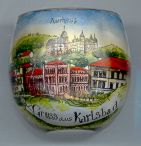 The famous spa town Karlovy Vary (German: Karlsbad) is situated at an elevation of 370 mat the site where the Teplá
(Tepl) flows into the river Ohře (Eger). The city centre with the town's administration, the residential and industrial
areas are located in the broad Eger valley while the spa facilities are located in the narrow valley of the Teplá.
Karlovy Vary is the administrative seat of the Karlovy Vary district and has a population of about 52,400 (2003).
The famous spa town Karlovy Vary (German: Karlsbad) is situated at an elevation of 370 mat the site where the Teplá
(Tepl) flows into the river Ohře (Eger). The city centre with the town's administration, the residential and industrial
areas are located in the broad Eger valley while the spa facilities are located in the narrow valley of the Teplá.
Karlovy Vary is the administrative seat of the Karlovy Vary district and has a population of about 52,400 (2003).
The place was chartered on the 14th August 1370 by Emperor Karl IV and was named after him. The popular story that the Emperor had discovered the warm springs while hunting in this area is a legend. In fact, the earliest mention of the springs is found in a document issued in 1325 by King Johann I (John of Luxembourg). The waters were used for drinking cures since 1520, the first printed instructions were published two years later. In 1707 the town obtained the status of a free royal town by a patent issued by Emperor Joseph I. The first bath house was built in 1717 followed by many others in the following decades.
The Carlsbad Conference of August 1819, called in by the Austrian prime minister Prince Clemens Metternich, ended with the Carlsbad Resolutions. The resolutions aimed at defending the authority of the post-Napoleonic reactionary governments of the countries of the German Federation against the new, liberal and national ideas of the period. The Diet of the German Federation only reluctantly ratified the resolutions in September of the same year. In man countries, such as in Austria, the Carlsbad Resolutions were used to prohibit the political students' corporations, surveillance of the universities and censuring of the press. The Carlsbad Resolutions were finally abolished in the Revolution of 1848.
In 1939, after the occupation of the 'Sudetenland' by the Third Reich, the neighmoring communities of Aich (Doubí), Drahowitz (Drahovice), Espenthor (Olšová Vrata), Fischern (Rybáře), Maierhöfen (Dvory) and Weheditz (Bohatice) were incorporated into Karlsbad, which thus became the largest city of the region (at that time about 53,000). The strong German-speaking community, however, during that time also came in fierce opposition to the Czechs. After World war II the German-speaking population was expelled. The spa was nationalised in 1948. A total of fourteen hot springs is used by the spa. Another important tourist attraction is the international film festival which takes place here since 1948. In 2021, Karlovy vary was listed by UNESCO as a World Cultural Heritage site (see list) as one of the "Great Spas of Europe", together with Baden (Austria), Spa (Belgium), Františkovy Lázně and Mariánské Lázné (Czech Republic), Bad Ems, Bad Kissingen and Baden-Baden (Germany), Montecatini Terme (Italy), and Bath (United Kingdom).

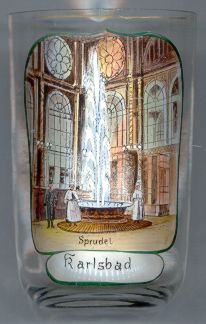
The  Vřídelní kolonáda (Sprudel-Kolonnade, Spring Colonnade)
[left: no. 695, below: no. 802, below right: no. 870]
houses the best-known of the springs of Karlovy Vary.
The
Vřídelní kolonáda (Sprudel-Kolonnade, Spring Colonnade)
[left: no. 695, below: no. 802, below right: no. 870]
houses the best-known of the springs of Karlovy Vary.
The  "Vřídlo"
"Vřídlo"
(See also list of further buildings by Fellner and Helmer)
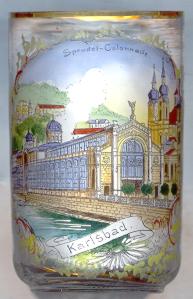 that are depicted on glasses of this collection.)
that are depicted on glasses of this collection.)
The Catholic  church of St. Magdalene [far right in the pictures]
was first mentioned in 1485. At the time it came under the patronage of the Knights of the Cross with the Red Star.
Since 1491 it had the status of an independent parish church. A new church was built in its place in 1518. The church
that we see today was built in 1733–1736 acording to a plan designed by Kilian Ignaz Dientzenhofer. The upper parts
of the two towers with their 'onion' roofs were created in 1861. Since 2010 the church is listed as a Czech national
cultural heritage.
church of St. Magdalene [far right in the pictures]
was first mentioned in 1485. At the time it came under the patronage of the Knights of the Cross with the Red Star.
Since 1491 it had the status of an independent parish church. A new church was built in its place in 1518. The church
that we see today was built in 1733–1736 acording to a plan designed by Kilian Ignaz Dientzenhofer. The upper parts
of the two towers with their 'onion' roofs were created in 1861. Since 2010 the church is listed as a Czech national
cultural heritage.
[https://de.wikipedia.org/wiki/St._Maria_Magdalena_(Karlsbad)]
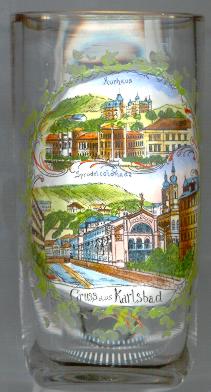 The top picture on glass no. 870 shows a view of
The top picture on glass no. 870 shows a view of  Kurhaus
Kurhaus
[https://windsor-carlsbad.cz/de/complex/history]
The complex depicted in the top background is  Villa Theresa
Villa Theresa
[https://de.wikipedia.org/wiki/Liste_von_Bauwerken_in_Karlovy_Vary]
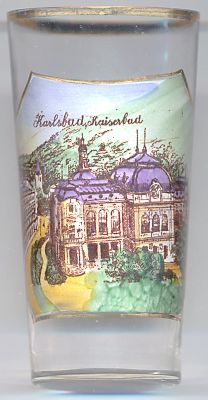
The  Císařské lázně (Kaiserbad) (today Bath I) [left: no. 2382]
was built by the architects Ferdinand Fellner and Hermann Helmer in 1893–1895
in French Renaissance revival and Art déco style. A luxury appartment on the upper floor once was
reserved exclusively for Emperor Franz Joseph I.
Císařské lázně (Kaiserbad) (today Bath I) [left: no. 2382]
was built by the architects Ferdinand Fellner and Hermann Helmer in 1893–1895
in French Renaissance revival and Art déco style. A luxury appartment on the upper floor once was
reserved exclusively for Emperor Franz Joseph I.
(See also list of further buildings by Fellner and Helmer)
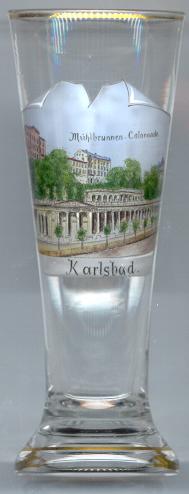
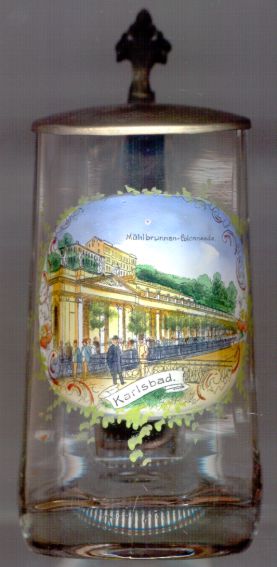
The  Mlýnská kolonáda (Mühlbrunnen-Kolonnade) [left: no. 629, and right: no. 1275]
houses the spring which was named after a mill that was located next to it until the 18th century. The spring
supplies waters of 52.7°C and was already known in the 16th century. In the early 18th century this was the site of
Karlovy Vary's first bath house. Since 1773 the spring is in possession of the municipality.
The colonnade was built in 1871–1881 by Josef Zítek. The colonnade is 132 m long, its roof is supported by 124 corinthian columns.
Mlýnská kolonáda (Mühlbrunnen-Kolonnade) [left: no. 629, and right: no. 1275]
houses the spring which was named after a mill that was located next to it until the 18th century. The spring
supplies waters of 52.7°C and was already known in the 16th century. In the early 18th century this was the site of
Karlovy Vary's first bath house. Since 1773 the spring is in possession of the municipality.
The colonnade was built in 1871–1881 by Josef Zítek. The colonnade is 132 m long, its roof is supported by 124 corinthian columns.
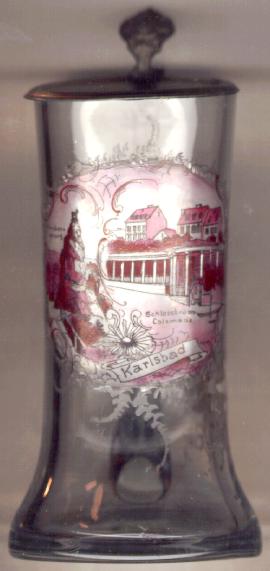
The  Zámecká kolonáda (Schlossbrunn-Kolonnade) is depicted on glass no. 513 [left: right picture].
The colonnade was built by architect Friedrich Ohmann in 1911–1913 and houses the spring "Unterer Schlossbrunnen". The oldest reports of this spring (61.4°C) date from 1769, but
it was certainly used already earlier. When the "Vřídlo"/"Sprudel" spring erupted in 1809, this spring ran dry and only began
to flow again fourteen years later.
Zámecká kolonáda (Schlossbrunn-Kolonnade) is depicted on glass no. 513 [left: right picture].
The colonnade was built by architect Friedrich Ohmann in 1911–1913 and houses the spring "Unterer Schlossbrunnen". The oldest reports of this spring (61.4°C) date from 1769, but
it was certainly used already earlier. When the "Vřídlo"/"Sprudel" spring erupted in 1809, this spring ran dry and only began
to flow again fourteen years later.
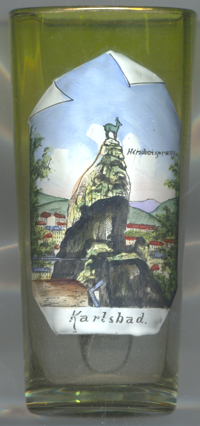
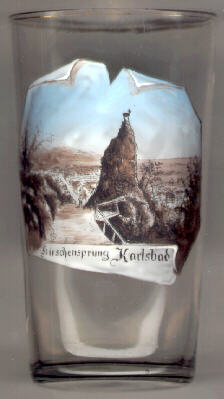
The  Jelení skok (Hirschensprung)
[near left, no. 3092; and right, no. 344; also depicted on glass no. 513, far left]
is a popular place for excursions from Karlovy Vary. Located high on a hill above the town, it is the place that was told to
be site where a dear that was chased by Emperor Karl IV jumped down and thus caused the legendary discovery of the
hot springs. A monument in form of a chamois buck on the tip of the rock commemorates this story.
Jelení skok (Hirschensprung)
[near left, no. 3092; and right, no. 344; also depicted on glass no. 513, far left]
is a popular place for excursions from Karlovy Vary. Located high on a hill above the town, it is the place that was told to
be site where a dear that was chased by Emperor Karl IV jumped down and thus caused the legendary discovery of the
hot springs. A monument in form of a chamois buck on the tip of the rock commemorates this story.
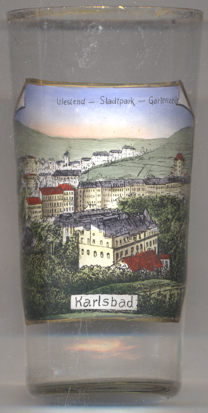
Glass no. 3306 [left] is labeled
Westend – Stadtpark – Gartenzeile (Westend, Municipal Park, Garden Row).
![[scale]](lineal.jpg)